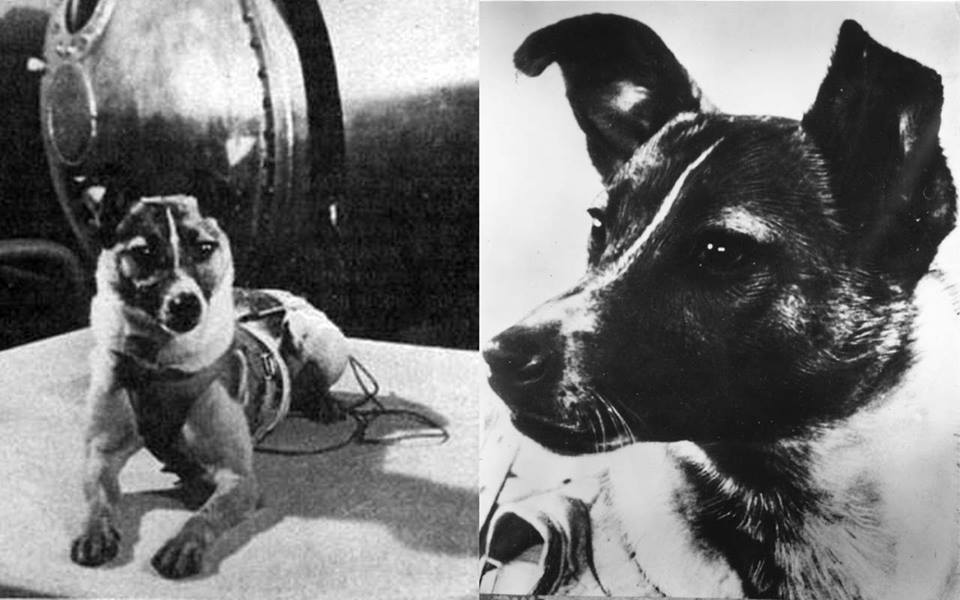Week 9: Space + Art
For the final unit of DESMA 9, Dr. Vesna dedicated her lecture to cover the intersection between space and art. While the last several units regarded the relationship between the field of medicine and art, which is minuscule in size, space provides yet another example of the connection between science and art.
 |
| Laika, the Soviet space dog http://www.howlofadog.org/wp-content/uploads/2015/05/laika-4.jpg |
The powers of ten blog and video put into perspective how small not only humans are but also Earth is in respect to the universe. As a result, human fascination with infinitely large universe and its unknown contents has led to numerous works of art. During the Russians' early attempts to survey the practicality of space travel for living creatures, they sent a dog, Laika, to monitor the effects space has. Soon after, there was a song dedicated to the dog and its travel into space. Not only were there songs influenced by space travel, but entertainment companies eventually took notice in society's interest in space that led to numerous works including Planet Stories, The Jetsons, Lost in Space, Star Trek, E.T. the Extra-Terrestrial, and Star Wars.
 |
| Star Wars: The Force Awakens eclipsed the $2 billion mark at the worldwide box office http://blogs-images.forbes.com/olliebarder/files/2015/12/forceawakens_rey-1200x675.jpg |
In The Jetsons, in addition to space, there is a robot maid, Rosie, that plays a supporting role in the series. Consequently, the show gains its major influences from space exploration and robotics. Star Wars is a prime example of the human population's continuous interest in space as well as space-inspired art. With the first film debuting in 1977 and the most recent in 2015, the fan base has not diminished instead continues to grow. Star Wars is also a great example of the topics covered in DESMA 9 as the culmination of mathematics to create aesthetically pleasing landscapes and vehicles, humanoids, and the setting of a far away galaxy with extra-terrestrial life connects mathematics, robotics, and space to produce an exceptional work of art. On the other hand, the space elevator is a concept theorized by novelists that scientists are constantly exploring, which is an example of art-inspired science.
The Continental Drift suggests, "moving away from the creation of recognizable works, art becomes an experimental territory for producing subjectivities." Likewise, Roger Molina from the Leonardo Space Art Project says, "the space age was possible because for centuries the cultural imagination was fed by artists, writers and musicians who dreamed of human activities in space." Truly, the uncertainty of what lies beyond Earth provides artists the opportunity to use their imaginations to create possible outcomes. And with endless possibilities that results, scientists become indefatigable in their efforts to find out the truth.
Works Cited
"CODED UTOPIA." Continental Drift. N.p., 27 Mar. 2007. Web. 27 May 2016.
EamesOffice. "Powers of Ten™ (1977)." YouTube. YouTube, 26 Aug. 2010. Web. 27 May 2016.
"Leonardo Space Art Project Visioneers." Leonardo Space Art Project Visioneers. N.p., n.d. Web. 27 May 2016.
Marlow. "An Eames Office Website." Powers of Ten Blog. N.p., n.d. Web. 27 May 2016.
Uconlineprogram. "Space Pt1, Pt2, Pt3, Pt4, Pt5, Pt6." YouTube. YouTube, 30 May 2012. Web. 27
May 2016.
EamesOffice. "Powers of Ten™ (1977)." YouTube. YouTube, 26 Aug. 2010. Web. 27 May 2016.
"Leonardo Space Art Project Visioneers." Leonardo Space Art Project Visioneers. N.p., n.d. Web. 27 May 2016.
Marlow. "An Eames Office Website." Powers of Ten Blog. N.p., n.d. Web. 27 May 2016.
Uconlineprogram. "Space Pt1, Pt2, Pt3, Pt4, Pt5, Pt6." YouTube. YouTube, 30 May 2012. Web. 27
May 2016.

Comments
Post a Comment